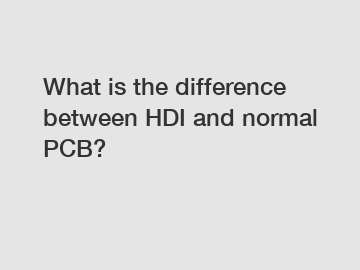What is the difference between HDI and normal PCB?
What is the difference between HDI and normal PCB?
HDI (High Density Interconnect) and normal PCB (Printed Circuit Board) are two terms that come up frequently in the world of electronics. Both serve as essential components in many electronic devices, enabling the smooth flow of electrical signals. However, there are several key differences between the two. In this article, we will explore the dissimilarities between HDI and normal PCB, shedding light on their distinct features and applications.
1. Construction and Layer Density:

HDI PCBs are constructed using advanced technology, allowing for increased layer density compared to normal PCBs. HDI technology enables intricate layer stacking, utilizing microvias to connect different layers. This characteristic results in a higher density of circuitry, making HDI PCBs more compact and efficient. On the other hand, normal PCBs typically have fewer layers and rely on through-hole vias, which limits their overall density.
2. Miniaturization and Space Efficiency:
The heightened layer density in HDI PCBs offers an advantage in terms of miniaturization and space efficiency. As electronic devices become increasingly compact, the demand for smaller and lighter PCBs rises. HDI technology allows for the design and production of smaller PCBs capable of accommodating a larger number of components. In contrast, normal PCBs have limitations in achieving the same level of miniaturization due to their lower layer density.
3. Signal Integrity and Electrical Performance:
Another significant disparity lies in the signal integrity and electrical performance of HDI and normal PCBs. HDI technology, with its reduced layer count and shorter interconnection paths, contributes to superior signal integrity. The shorter interconnections reduce signal loss, crosstalk, and electromagnetic interference, resulting in improved overall electrical performance. Normal PCBs, with their longer traces and greater distance between components, are more prone to signal degradation.
4. Assembly Process and Cost:
When it comes to the assembly process, HDI PCBs require more advanced techniques due to their increased layer density and microvias. This complexity translates into higher manufacturing costs compared to normal PCBs. The use of HDI technology requires specialized equipment and skilled personnel, contributing to a more substantial investment. Conversely, normal PCBs have a simpler assembly process, making them a cost-effective solution for applications that do not require an ultra-high density design.
In conclusion, HDI and normal PCBs serve distinct purposes and offer different advantages depending on the specific requirements of an electronic device. HDI technology provides superior miniaturization, space efficiency, and signal integrity but comes at a higher cost due to its complex manufacturing process. Normal PCBs, while less dense and compact, offer an affordable option for applications that do not demand extreme miniaturization. Understanding the differences between HDI and normal PCBs is crucial for electronics designers and manufacturers to choose the appropriate option for their specific needs.
In summary, HDI and normal PCBs differ in terms of construction, layer density, miniaturization, signal integrity, assembly process, and cost. Each option has its own set of advantages and considerations, and accurately assessing the requirements of a given electronic device is vital for making an informed choice between the two. Whether it's a smartphone, a medical device, or any other electronic equipment, the selection of the right PCB type is a key factor in ensuring optimal performance and functionality.
Are you interested in learning more about pcba for security system, communication pcba, esd anti-static intelligent monitoring system? Contact us today to secure an expert consultation!


